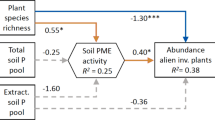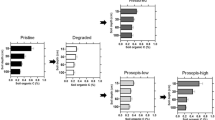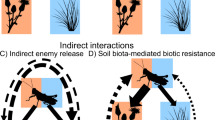Abstract
Returning native species to habitats degraded by biological invasions is a critical conservation goal1. A leading hypothesis poses that exotic plant dominance is self-reinforced by impacts on ecosystem processes, leading to persistent stable states2,3,4,5,6. Invaders have been documented to modify fire regimes, alter soil nutrients or shift microbial communities in ways that feed back to benefit themselves over competitors2,5,6,7. However, few studies have followed invasions through time to ask whether ecosystem impacts and feedbacks persist8,9. Here we return to woodland sites in Hawai′i Volcanoes National Park that were invaded by exotic C4 grasses in the 1960s, the ecosystem impacts of which were studied intensively in the 1990s10,11,12. We show that positive feedbacks between exotic grasses and soil nitrogen cycling have broken down, but rather than facilitating native vegetation, the weakening feedbacks facilitate new exotic species. Data from the 1990s showed that exotic grasses increased nitrogen-mineralization rates by two- to fourfold, but were nitrogen-limited10,12,13. Thus, the impacts of the invader created a positive feedback early in the invasion. We now show that annual net soil nitrogen mineralization has since dropped to pre-invasion levels. In addition, a seedling outplanting experiment that varied soil nitrogen and grass competition demonstrates that the changing impacts of grasses do not favour native species re-establishment. Instead, decreased nitrogen availability most benefits another aggressive invader, the nitrogen-fixing tree Morella faya. Long-term studies of invasions may reveal that ecosystem impacts and feedbacks shift over time, but that this may not benefit native species recovery.
This is a preview of subscription content, access via your institution
Access options
Subscribe to this journal
Receive 51 print issues and online access
$199.00 per year
only $3.90 per issue
Buy this article
- Purchase on Springer Link
- Instant access to full article PDF
Prices may be subject to local taxes which are calculated during checkout




Similar content being viewed by others
References
Dobson, A. P., Bradshaw, A. D. & Baker, A. J. M. Hopes for the future: restoration ecology and conservation biology. Science 277, 515–522 (1997)
D’Antonio, C. M. & Vitousek, P. M. Biological invasions by exotic grasses, the grass fire cycle, and global change. Annu. Rev. Ecol. Syst. 23, 63–87 (1992)
Suding, K. N., Gross, K. L. & Houseman, G. R. Alternative states and positive feedbacks in restoration ecology. Trends Ecol. Evol. 19, 46–53 (2004)
Callaway, R. M., Thelen, G. C., Rodriguez, A. & Holben, W. E. Soil biota and exotic plant invasion. Nature 427, 731–733 (2004)
Kulmatiski, A., Beard, K. H., Stevens, J. R. & Cobbold, S. M. Plant–soil feedbacks: a meta-analytical review. Ecol. Lett. 11, 980–992 (2008)
van der Putten, W. H., Klironomos, J. N. & Wardle, D. A. Microbial ecology of biological invasions. ISME J. 1, 28–37 (2007)
Yelenik, S. G. & Levine, J. M. The role of plant–soil feedbacks in driving native species recovery. Ecology 92, 66–74 (2011)
Strayer, D. L., Eviner, V. T., Jeschke, J. M. & Pace, M. L. Understanding the long-term effects of species invasions. Trends Ecol. Evol. 21, 645–651 (2006)
Levine, J. M., Pachepsky, E., Kendall, B. E., Yelenik, S. G. & Lambers, J. H. Plant–soil feedbacks and invasive spread. Ecol. Lett. 9, 1005–1014 (2006)
Mack, M. C. & D’Antonio, C. M. Exotic grasses alter controls over soil nitrogen dynamics in a Hawaiian woodland. Ecol. Appl. 13, 154–166 (2003)
D’Antonio, C. M., Hughes, R. F. & Vitousek, P. M. Factors influencing dynamics of two invasive C4 grasses in seasonally dry Hawaiian woodlands. Ecology 82, 89–104 (2001)
Hughes, F., Vitousek, P. M. & Tunison, T. Alien grass invasion and fire in the seasonal submontane zone of Hawaii. Ecology 72, 743–746 (1991)
D’Antonio, C. M. & Mack, M. C. Nutrient limitation in a fire-derived, nitrogen-rich Hawaiian grassland. Biotropica 38, 458–467 (2006)
Pimentel, D., Zuniga, R. & Morrison, D. Update on the environmental and economic costs associated with alien-invasive species in the United States. Ecol. Econ. 52, 273–288 (2005)
Simberloff, D. Invasional meltdown 6 years later: important phenomenon, unfortunate metaphor, or both? Ecol. Lett. 9, 912–919 (2006)
Mack, M. C., D’Antonio, C. M. & Ley, R. E. Alteration of ecosystem nitrogen dynamics by exotic plants: a case study of C4 grasses in Hawaii. Ecol. Appl. 11, 1323–1335 (2001)
Allison, S. D. & Vitousek, P. M. Rapid nutrient cycling in leaf litter from invasive plants in Hawai′i. Oecologia 141, 612–619 (2004)
Vitousek, P. M. & Walker, L. R. Biological invasion by Myrica faya in Hawai′i: plant demography, nitrogen fixation, ecosystem effects. Ecol. Monogr. 59, 247–265 (1989)
Bever, J. D., Westover, K. M. & Antonovics, J. Incorporating the soil community into plant population dynamics: the utility of the feedback approach. J. Ecol. 85, 561–573 (1997)
Suding, K. N. & Hobbs, R. J. Threshold models in restoration and conservation: a developing framework. Trends Ecol. Evol. 24, 271–279 (2009)
Beisner, B. E., Haydon, D. T. & Cuddington, K. Alternative stable states in ecology. Front. Ecol. Environ. 1, 376–382 (2003)
Scheffer, M., Carpenter, S., Foley, J. A., Folke, C. & Walker, B. Catastrophic shifts in ecosystems. Nature 413, 591–596 (2001)
Tilman, D. Secondary succession and the pattern of plant dominance along experimental nitrogen gradients. Ecol. Monogr. 57, 189–214 (1987)
Sullivan, J. J., Williams, P. A. & Timmins, S. M. Secondary forest succession differs through naturalised gorse and native kanuka near Wellington and Nelson. N. Z. J. Ecol. 31, 22–38 (2007)
Beatty, S. W. & Licari, D. L. Invasion of fennel (Foeniculum vulgare) into shrub communities on Santa Cruz Island, California. Madroño 39, 54–66 (1992)
D’Antonio, C. M., Hughes, R. F. & Tunison, J. T. Long-term impacts of invasive grasses and subsequent fire in seasonally dry Hawaiian woodlands. Ecol. Appl. 21, 1617–1628 (2011)
Nadelhoffer, K. J. & Fry, B. in Stable Isotopes in Ecology and Environmental Science Vol. 316 (eds Lajtha, K. & Michener, R. M. ) 22–44 (Blackwell, 1994)
Scowcroft, P. G. Parent tree effects on reestablishment of Acacia koa in abandoned pasture and the influence of initial density on stand development. New Forests 44, 409–426 (2013)
Funk, J. L., Cleland, E. E., Suding, K. N. & Zavaleta, E. S. Restoration through reassembly: plant traits and invasion resistance. Trends Ecol. Evol. 23, 695–703 (2008)
Mack, M. C. Effects of Ecotic Grass Invasion on Ecosystem Nitrogen Dynamics in a Hawaiian Woodland. PhD thesis, Univ. California, Berkeley. (1998)
Acknowledgements
We thank M. Mack for previous data. We thank S. McDaniel and S. Doyle for native seed and the National Park Service for field site access and laboratory and greenhouse facilities. N. DiManno, V. Vincent, T. Kalei, T. D’Antonio-Dudley, K. Roehr, W. Buckley, M. Wasser and C. French helped with field work and N. DiManno, V. Vincent and S. Ma helped with laboratory work. We are appreciative of early manuscript comments from E. Mordecai and statistical advice from K. Brinck. This research was funded by National Science Foundation grant DEB 1029168.
Author information
Authors and Affiliations
Contributions
S.G.Y. and C.M.D. conceived and designed the study, managed the project, performed laboratory and field work and edited the manuscript. S.G.Y. analysed the data, developed the figures and drafted the initial manuscript.
Corresponding author
Ethics declarations
Competing interests
The authors declare no competing financial interests.
Extended data figures and tables
Extended Data Figure 1 Monthly rainfall over the study periods, and the 25-year average monthly rainfall.
Monthly rainfall over the course of 1 year during the 1995 and 2011 year-long sampling periods for net N mineralization (Fig. 1a). The last point in the series shows the average monthly rainfall for that year (points are means ± 1 s.e.). Also shown in blue is the same data for the 25-year rainfall average. Note that 1995 and 2011 have similar rainfall on average over the year, approximately 45% lower than the 25-year rainfall average.
Extended Data Figure 2 Relationship between net N mineralization and rainfall over the study periods.
Differences in net N mineralization between exotic grassland and native Metrosideros woodland sites in relation to monthly rainfall for the 1994–95 and 2011–12 study periods. The lack of relationship (r2 = 0.01, P = 0.74, n = 11) between site differences and monthly rainfall suggests that rainfall did not drive patterns in net N mineralization, or the relationship between invaded and intact woodland sites (Fig. 1a).
Extended Data Figure 3 Potential net N mineralization from laboratory assays.
Net N-mineralization incubations from the laboratory, where soils were held at 70% water-holding capacity and 23 °C. That there was no difference between exotic grassland and native woodland habitats (one-way ANOVA, habitat as fixed effect: P = 0.19, n = 10) matches results from intact field cores (Fig. 1a), suggesting that differences in climate between sites, which may have varied in the field, did not alter general results for net N mineralization. Bars represent means ± 1 s.e. We also ran the analysis with a Kruskal–Wallis test to account for unequal variances, although results were similar (P = 0.43, n = 10).
Extended Data Figure 4 RGRs for seedlings in the outplanting experiment.
RGRs were calculated after 8 months for the native seedlings (a–e) and the exotic seedlings (f, g). a, Dodonaea viscosa (′ā′ali′i). b, Leptecophylla tameiameiae (pūkiawe). c, Osteomeles anthyllidifolia (′ūlei). d, Sophora chrysophylla (māmane). e, Acacia koa (koa). f, Morella faya (faya). g, Psidium guajava (guava). Bars represent means ± 1 s.e.
Rights and permissions
About this article
Cite this article
Yelenik, S., D’Antonio, C. Self-reinforcing impacts of plant invasions change over time. Nature 503, 517–520 (2013). https://doi.org/10.1038/nature12798
Received:
Accepted:
Published:
Issue Date:
DOI: https://doi.org/10.1038/nature12798
This article is cited by
-
Solidago canadensis invasion destabilizes the understory plant community and soil properties of coastal shelterbelt forests of subtropical China
Plant and Soil (2023)
-
Vegetation type and fire severity mediate short-term post fire soil microbial responses
Plant and Soil (2023)
-
Invasive nitrogen-fixing plants increase nitrogen availability and cycling rates in a montane tropical grassland
Plant Ecology (2022)
-
The long-term effect of initial restoration intervention, landscape composition, and time on the progress of Pannonic sand grassland restoration
Landscape and Ecological Engineering (2022)
-
Assessing changes to ecosystem structure and function following invasion by Spartina alterniflora and Phragmites australis: a meta-analysis
Biological Invasions (2021)
Comments
By submitting a comment you agree to abide by our Terms and Community Guidelines. If you find something abusive or that does not comply with our terms or guidelines please flag it as inappropriate.



